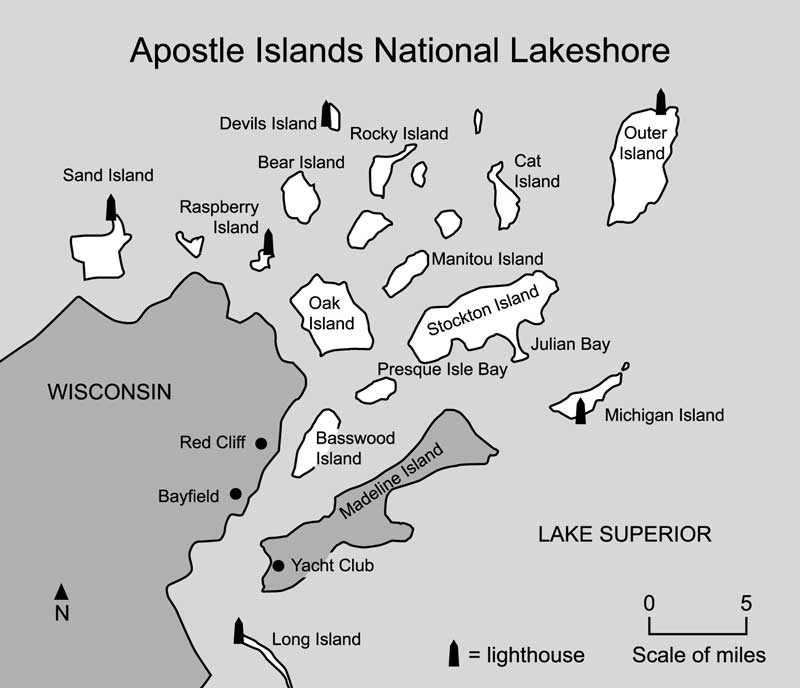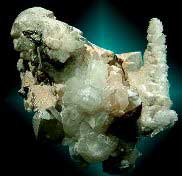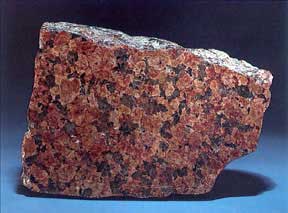Beach Rocks of the Apostle Islands
 |
The Apostle Islands were shaped during the last ice age, which ended
about 10,000 years ago. As continental glaciers advanced through the region
they scoured the landscape, removing debris down to the sandstone bedrock.
As the glaciers retreated they left deposits of glacial till composed of
boulders, gravel, and sand across the landscape. This is the source of the
various rocks found in the islands today.
Beach Sand
Most beach sand in the Apostle Islands is composed predominantly of quartz
and feldspar. Other minerals include olivine, hornblende, and augite.
Geologically, the sand is young, reflecting its origin from glacial
deposits, stream deposits, and shoreline erosion.
Coal/Glass/Driftwood
Coal is a black or brown rock. Itís luster ranges from dull to shiny black
to iridescent. Glass is a man-made material that is sometimes found on Lake
Superior beaches. It may be blue, green, or brown, but white is the most
common color. The edges of glass fragments are often worn smooth with the
surfaces pitted from rolling in the sand. Driftwood ranges in size from
whole trees to small splinters. It can be mistaken for rock because it is
striated and may have sand particles imbedded in its surface.
History-Coal is an organic sedimentary rock consisting of the altered
remains of plants. Coal does not occur naturally along the Lake Superior
shoreline. Shipwrecks and the careless handling of cargo are the sources of
most of the coal found on our beaches.
 |
Basalt
Basalt is a smooth bluish-black rock. Wet basalt has a much darker
appearance than dry basalt, which is blue-gray.
History-Basalt is an igneous rock that forms from quickly cooling lava.
Basalt found in the park is hundreds of millions of years old.
 |
Quartz
Quartz rocks found here are usually small and may be in a variety of colors.
Quartz may appear clear to cloudy and even slightly yellowish. It cannot be
scratched with a knife.
History-Quartz is a common mineral. It is found in many rock types and in
beach sand.
 |
Slate
Slate is often blue-gray in color but may be green, red, or brown. It breaks
easily along a flat plane and is often split into sheets and used for
roofing or blackboards.
History-Slate is a metamorphic rock that forms by the alteration of the
sedimentary rock shale by heat and pressure.
 |
Granite
Granite may be white or reddish with black flecks, or other combinations of
pink, gray, white, red, black, or yellow.
History-Granite is an igneous rock that forms from magma deep underground.
The slow cooling process allows minerals to form crystals, giving the rock a
speckled appearance.
 |
Sandstone
Sandstone is a brownish to reddish coarse grained rock also known as
brownstone. Sandstone rocks may be striped or solid in color. Individual
grains of sand are often visible. Sandstone is the bedrock underlying the
Apostle Islands. This rock was once quarried as building material. Old
quarries are on Stockton, Basswood, and Hermit islands.
History-Sandstone, a sedimentary rock, forms when individual grains of sand
are cemented together by various minerals.
Rhyolite
Rhyolite is usually reddish or pale salmon in color. The stone is smooth and
hard with small surface holes called vesicles.
History-Rhyolite is an igneous rock with fine crystalline structure that
forms from quickly cooling magma. It contains the same minerals as granite.
Beach sand, coal, glass, driftwood, basalt, quartz, slate, granite,
sandstone, and rhyolite rocks make up the majority of the Apostle Islands
shoreline. Everyone is welcome to come walk the shoreline and enjoy. See if
you can identify which rock is which!
All contents are copyright (c) 2007 by
Northern Breezes, Inc. All information contained within is deemed reliable
but carries no guarantees. Reproduction of any part or whole of this
publication in any form by mechanical or electronic means, including
information retrieval is prohibited except by consent of the publisher.